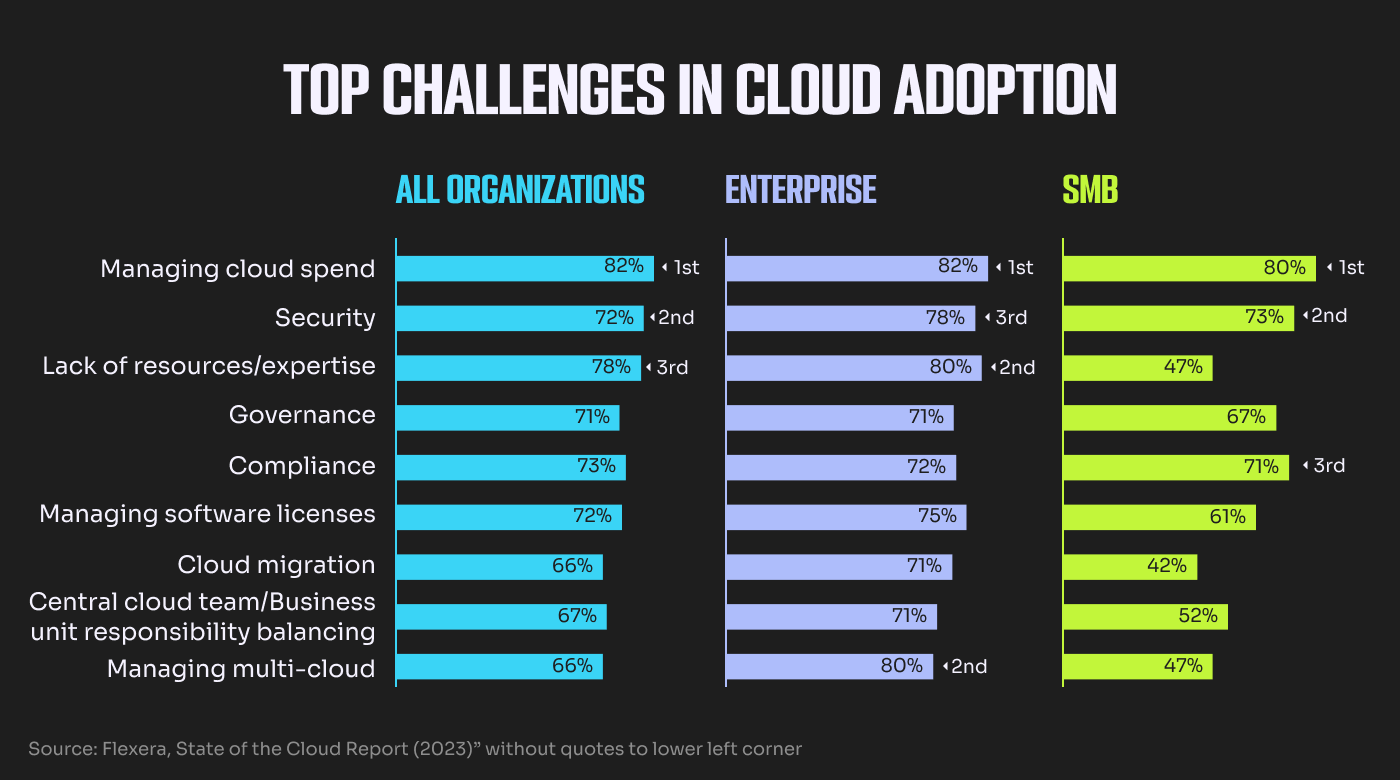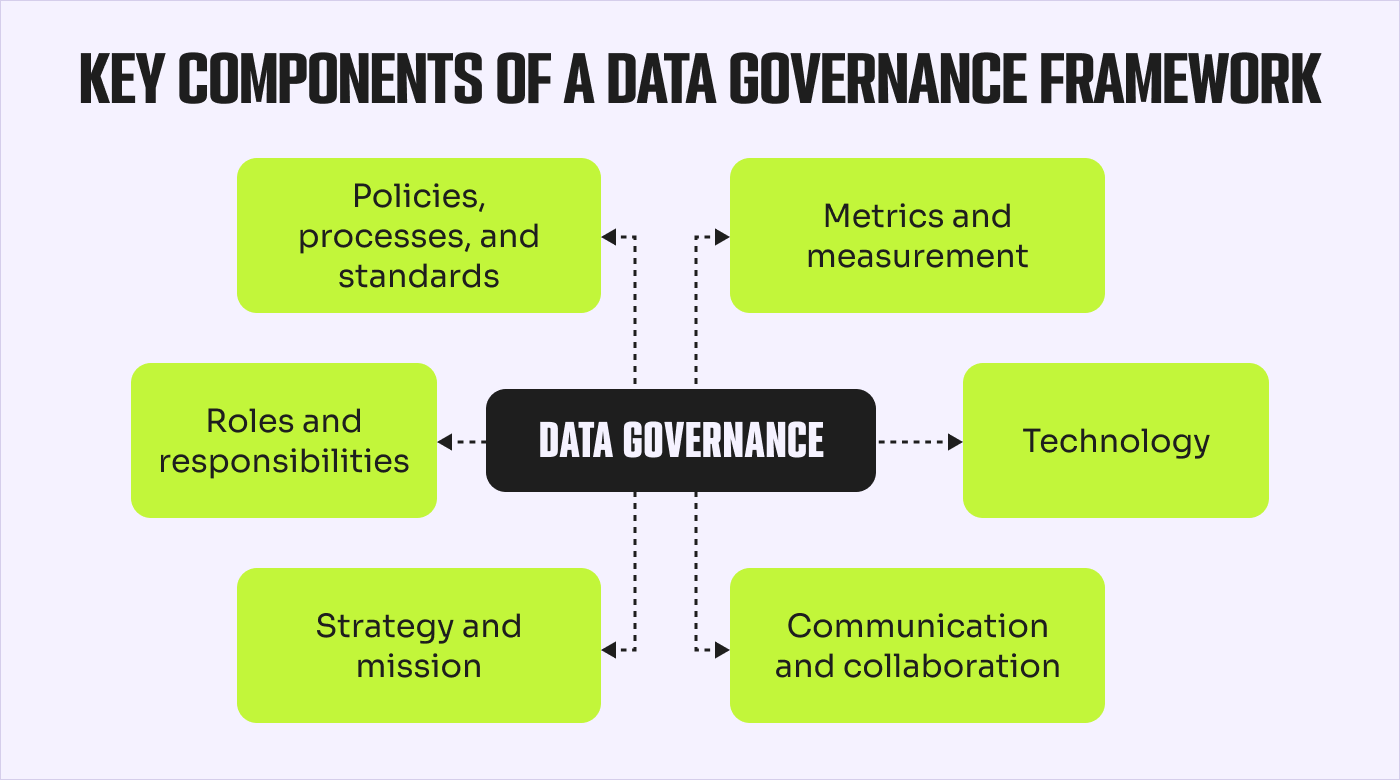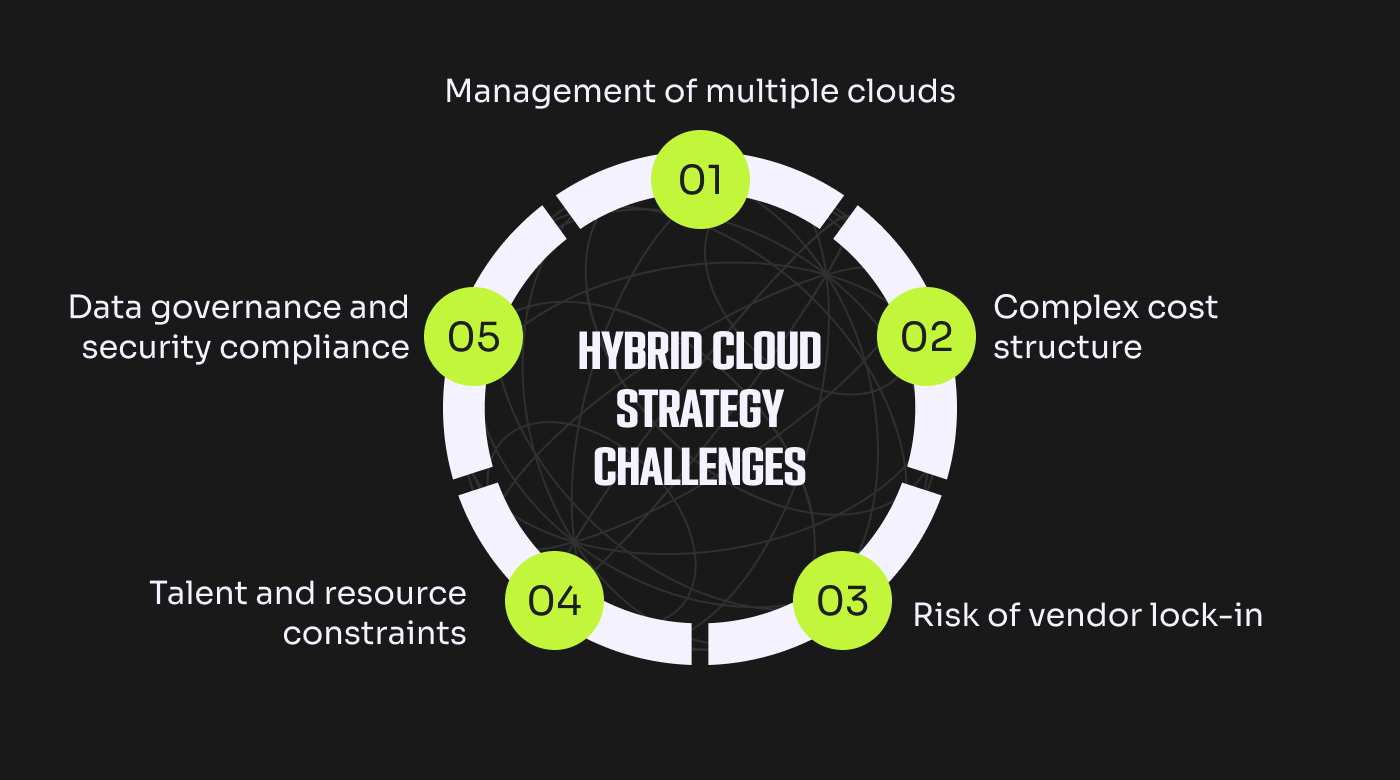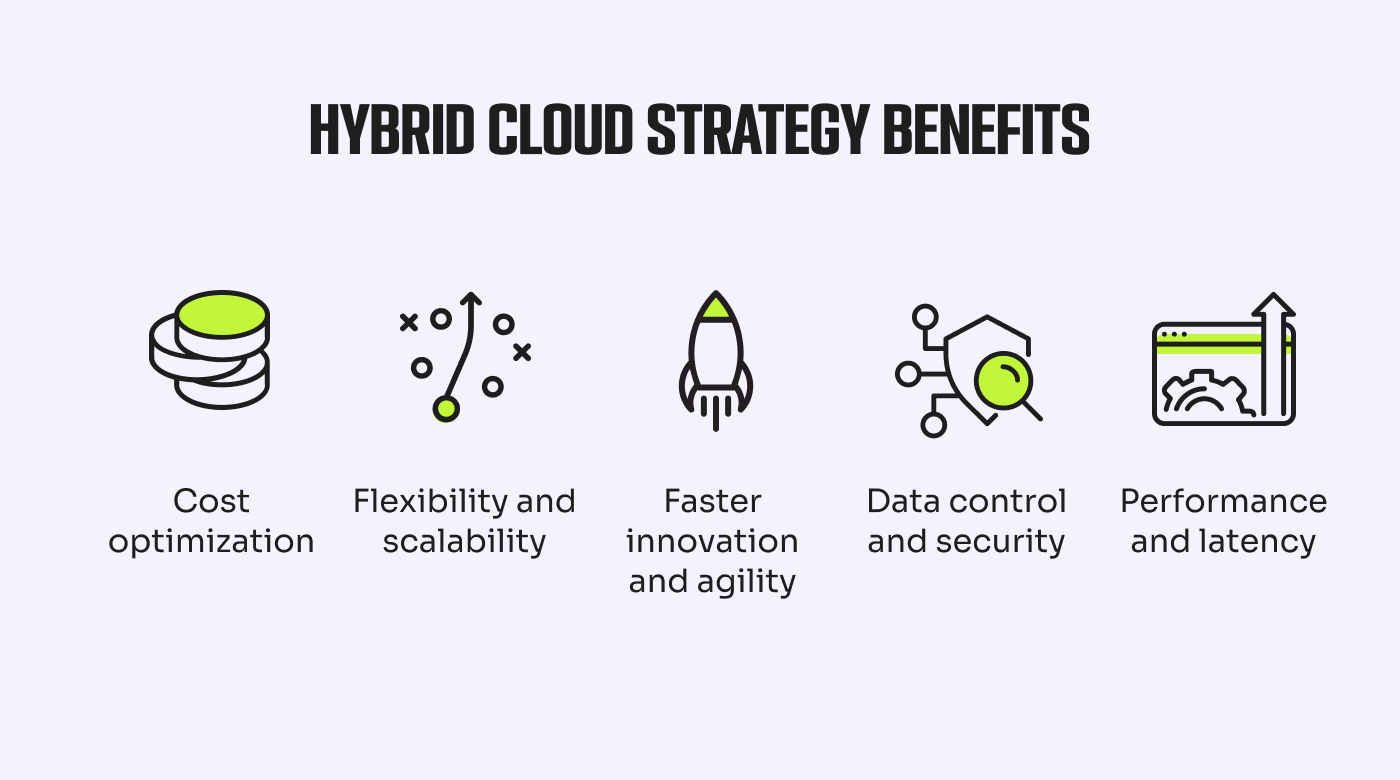As of 2023, 72% of enterprises have moved toward a hybrid cloud model, combining one or more private or public clouds with an on-premise data center.
A hybrid approach gives you both the agility of the cloud and the firsthand control of on-premise infrastructure. This combination allows you to strike a balance between the two systems that can optimize costs, security, and scalability.
Below, I'll cover the essential considerations for your hybrid cloud strategy, including the fundamentals of cloud infrastructure, common challenges you may encounter, and the benefits you can expect from adopting a hybrid cloud model.
What Is a Hybrid Cloud Strategy?
A hybrid cloud strategy combines an on-premise system with one or more public or private clouds to create an integrated IT environment. Companies that use this approach typically do so to take advantage of the benefits of the public cloud, like flexibility and scalability, without sacrificing those that come with on-prem infrastructure, including security and control.

Adopting a hybrid cloud strategy has gained popularity as it offers the right mix of benefits for digital transformation. 72% of IT leaders have adopted a hybrid approach.
Many companies undergoing a hybrid cloud transformation have complex legacy IT systems that they want to maintain while accounting for regulation compliance requirements, distributed operations, and dynamic workloads.
For example, Arek Oy, a Finnish pension company, migrated to Google Cloud while keeping some of its sensitive and confidential customer and pension data on-premises. Their goal was to streamline the pension calculation process and improve customer satisfaction.
Using the Kubernetes infrastructure on Anthos instead of its legacy mainframe, Arek Oy lowered its cost per transaction by over 80%. They leveraged the power of the Google Cloud platform to scale operations while using on-premises systems to comply with regulatory requirements.
How To Build a Hybrid Cloud Strategy
A hybrid cloud strategy requires making critical decisions about which applications and data will remain in the public cloud and which will stay in private or on-premise systems.
While these decisions are unique to your business context and goals, you can follow the framework below to work on your hybrid cloud strategy.
1. Assess Workload Requirements Across Your Infrastructure
The first step is to assess your existing applications and workload requirements to get an accurate representation of your existing systems and processes. This helps ensure you can map them effectively onto a different environment.

Not every business application needs to transition to a public cloud. You’ll need to determine which applications require the flexibility and speed of a public cloud and which do not. Some workloads may be better off remaining in a data center for reasons such as cost-effectiveness, granular configuration of infrastructure, and compliance or data governance requirements.
Assess which applications are critical to your business operations and prone to performance fluctuations in the event of a demand spike. These are usually consumer-facing applications that must be available 24/7 for reliable performance. Moving these applications to public cloud environments where you can scale their usage based on demand would make sense.
Something else you’ll need to consider in this step is the human capital you have at your disposal. Try to sniff out any team members with unique strengths that can make the transition more manageable and get their perspective on the planned strategy. As I see it, a second opinion is always worth the time, and you might uncover something you’d previously overlooked.
You’ll also need to understand the performance requirements of your infrastructure before moving on from workload assessment: Can the applications function in a virtualized environment, or do they require high-performance computing resources? Determining these requirements early on will ensure a smoother transition to a hybrid cloud model.
2. Lay Out Your Vision and Business Objectives
A hybrid cloud strategy isn't merely about embracing new technology for the sake of it — it's about incorporating tools that help you work toward your business objectives.

Your organization's financial standing and expenditure preferences also shape the cloud model. You’ll need to calculate how cloud migration will affect your capital and operating expenses. Many public cloud providers charge by usage and offer estimation tools you can use for budgeting.
You must also consider the long-term business strategy in this process. Depending on whether you aim to manage your cloud internally or opt for a managed service, your approach will shape the complexity and cost of your hybrid cloud architecture and influence your choice of cloud service provider.
3. Integrate and Manage Data
The effective management and integration of data form the backbone of a hybrid cloud infrastructure. Understanding the integration capabilities of your chosen cloud service provider is fundamental.
Some of the questions you can ask are:
- How well do their systems mesh with your existing infrastructure?
- Do they provide the tools necessary for smooth data migration and management?

Consider the interoperability of your hybrid cloud setup. Evaluate how different cloud environments within your strategy communicate with each other and with your on-premise infrastructure. When you understand the flow of data, where it resides, and how to retrieve it, you can create a strategy that enables efficient and effective data management.
4. Implement Security and Regulation Compliance
A robust security framework and strict adherence to industry regulations are vital to any hybrid cloud strategy.
The sensitive data of your organization may be distributed across various environments. This means you’ll have multiple infrastructure components across which you must implement robust protective measures and access control mechanisms. Look for a holistic security framework that allows you to manage security posture and monitor infrastructure across both on-prem and public cloud locations using a single pane of glass. Zero trust architecture and user-based access roles can ensure that only authorized personnel have access to sensitive data.
Strong cloud data governance protocols and other protocols should be in place up front so you won’t struggle to implement a system for these functions after you’ve scaled.

You should plan ahead for the personnel and workflows needed to maintain ongoing security monitoring once your system is up and running. This will include regular system updates and ongoing audits to enforce security standards and avoid compliance drift.
Remember to develop a dedicated incident response plan at this stage. In the case of a security breach, this plan would outline the steps to minimize the potential damage and restore your normal operations as quickly as possible.
5. Analyze Scalability and Performance Demand
A successful hybrid cloud strategy will require you to understand your needs for scaling and performance using deep analysis of your current resource allocation practices and fluctuations in workloads. When conducting these analyses, look at when resources are most in demand, how fast you can scale up to meet those demands, and how long it takes to scale back down afterward.
Consider the latency requirements of different applications to decide which applications should reside in the public cloud. For example, applications that require low latency might not be suitable for certain public cloud environments as it could negatively affect the end-user experience.
As your organization evolves, so will your cloud requirements. The cloud solution you choose should offer flexibility and scalability that align with your projected growth. This ensures your hybrid cloud strategy can adapt to meet your growing needs.
6. Plan for Disaster Recovery and Business Continuity
Your hybrid cloud strategy will need to withstand both predictable and unforeseen challenges, so you’ll have to seriously consider what disaster recovery and continuity plans you will put in place.

Between 2019 and 2022, 96% of businesses experienced outages that resulted in downtime. Depending on the kind of system you’re running, this might be a minor bump in the road or a catastrophe that vitally damages your core business. I recommend planning for disasters in advance so you don’t find out the hard way where you fall on that scale.
Regular backups of essential data and applications increase resilience and ensure minimal disruption during a disaster. Depending on the importance and sensitivity of the data, the backup could be hourly, daily, or weekly across multiple on-site and/or cloud storage locations for additional safety.
You should also consider how well your cloud service provider handles disaster recovery and whether they could strengthen your own systems in this regard. Look at factors such as how fast they can get back up after downtimes and what kinds of protocols they have in place to safeguard their customers against data loss.
7. Research Cloud Service Providers
After you’ve thoroughly evaluated your own systems and articulated your organizational needs, you'll be ready to choose a cloud service solution compatible with your unique goals.
When comparing cloud providers, go beyond their reputations and dig into the minute details of their services: look at their compliance track record, their technical performance, and their customer support. Try to find testimonials from customers in your industry, as they may be better predictors of what the hybrid cloud journey will entail for your company specifically.
First, consider the up-front time and effort required to migrate to a new provider. The complexity of this process can differ significantly based on the provider and your existing infrastructure. Use online calculators and consult IT experts to accurately estimate costs using your system’s unique specifications.
Next, factor in ongoing costs. Many providers offer enticing introductory rates, but you’ll want to consider the long-term costs once these discounts end. Managing spend in a hybrid cloud environment is one of the foremost challenges to plan for in your strategy, and while your budget may change in time, it’ll be easiest to stay on track if you begin with the most accurate forecast you can.
You should also note any vendor lock-in considerations and ensure that you don't have to pay a hefty price to migrate in the future. To ensure flexibility when migrating across different cloud environments, choose providers that use widely accepted standards and formats, such as microservices architecture and Kubernetes support.
8. Outline the Timeline for Cloud Adoption and Implementation
Cloud migration can be a lengthy and complicated process. Try to set a realistic timeline for your cloud adoption in the strategy phase itself.
Start by bringing all stakeholders up to speed with the details of your planned hybrid cloud strategy. This allows you to define responsibilities and set expectations that your teams can align with for a smooth transition. You should also open lines of communication and encourage feedback and collaboration.
At this stage, you must also set milestones to track the progress of your strategy. For example, these could include evaluating providers, migrating non-sensitive workloads, and eventually achieving full integration.
The implementation phase also involves thorough testing of the cloud environments to ensure they operate as expected and that all integrations with existing systems function correctly. Incorporate regular audits and system optimizations after implementation to give your new system a longer lifespan.
Challenges of Adopting a Hybrid Cloud Strategy
Leveraging multiple cloud environments gives businesses the flexibility and scalability they need to adapt to changing markets quickly, but adopting a cloud strategy is far from easy.

Here are some of the top challenges that organizations face as they navigate the hybrid cloud:
1. Managing Multiple Clouds
When you're juggling multiple cloud environments, system complexity escalates quickly. Different cloud platforms have their own unique tools, APIs, and interfaces, which adds to the challenge of management.
Hybrid cloud management is best done using dedicated cloud management tools that provide a holistic view and control over multiple cloud environments and processes. This approach treats your diverse cloud resources as a unified system, which unites siloed data and helps avoid gaps in security and compliance.
Cloud governance tools can help you manage cost, resource optimization, security, compliance, performance monitoring, and automation. Whether you're grappling with cost control, security, or operational workflows, the right management tool can make the process smoother, contributing significantly to the success of your hybrid cloud strategy.
2. Complex Cost Structure
Managing cloud spend remains the top priority for 82% of organizations. With multiple cloud service providers using varying pricing models, tracking cloud costs can be onerous.
The common usage-based pricing model can prove challenging to interpret if you’re looking to estimate costs upfront, so I recommend finding a provider with a free demo tier where you can conduct test runs to determine your usage and better understand what to expect when the bill comes.
Many platforms also have tools for customers to limit their own usage, especially regarding computing functions. Even if they don’t, they’ll usually allow you to integrate a third-party tool.
FinOps software offers a potential solution to this challenge. These tools offer granular visibility into cloud spending and enable you to track and control costs efficiently. They provide insights into usage trends and can forecast future costs based on historical data. By closely monitoring your usage, you can identify opportunities for savings and efficiency gains. For example, you can deprovision unnecessary resources or identify assets that can be migrated to newer, cheaper instances.
3. Risk of Vendor Lock-in
Vendor lock-in is a serious risk when adopting a hybrid cloud strategy. When you depend too much on a single cloud service provider, changing platforms can become a formidable challenge due to hefty switching costs. This one-sided reliance can affect your negotiating power for better pricing or services.
When you’re first starting out, you might get drawn in by the perks that one provider offers, then find out in the long run that it’s hurting you. To get around this, you could consider separating your needs and going with alternative vendors depending on which one meets each one the best.
Opt for providers who adhere to standard technologies and provide interoperability to mitigate lock-in risk. Additionally, you must have clear exit strategies and understand the costs and processes of switching providers before making any commitments.
You can also invest in open-source tools to create portable architectures and reduce dependence on one provider. By proactively strategizing for vendor independence, you give yourself the freedom to pivot in the future when the need arises.
4. Talent and Resource Constraints
Picture this: the IT team handling your on-premises infrastructure is suddenly thrown into the deep end of cloud technologies, teeming with new configurations, terminologies, and nuances. Or your software development team is suddenly tasked with using new SaaS tools in unfamiliar environments. These changes may be beneficial in the long run, but the short term may be full of inefficiencies.
Building and managing a hybrid cloud environment requires a specialized skill set that may not be available in-house. This skill set includes knowledge of cloud-based cybersecurity, multi-cloud management, cloud-native software development, and cloud cost optimization, to name a few. Without a team proficient in these areas, you might be in murky waters, struggling with deployment and subsequent operations.
So, how do you overcome this hurdle? Start with an audit of your existing capabilities. Then, if needed, invest in upskilling your staff or recruiting cloud-savvy talent. External training programs and certification courses can also bridge the skill gap. You can partner with a managed service provider to overcome this challenge, too.
5. Data Governance and Security Compliance
Increasing the footprint of your infrastructure with a hybrid cloud might result in data becoming scattered across different environments. Data visibility can be problematic in hybrid environments, as information can be siloed across providers or locations. Specialized tools are required to create holistic visibility throughout your infrastructure.
Security is also a challenge. Although cloud service providers have a good reputation for protecting their infrastructure layers, digital security is a shared responsibility, and cloud users are generally responsible for securing their own applications and workloads. By definition, the potential attack surface for a hybrid cloud network is more complex and dynamic than a traditional on-premises data center, so again, specialized cloud-native tools are needed.
Look for a unified platform solution that allows you to manage all your environments from one dashboard by providing tools for security, data governance, and related functions such as configuration and access control.
What Are the Benefits of a Hybrid Cloud Strategy?
With a hybrid cloud strategy, some of the benefits you might be able to reap include the following:

1. Cost Optimization
The ability to allocate different resources to different cloud environments depending on your needs can net you significant cost reductions. For instance, you can provision resources from the public cloud for as long as you need them and then spin down excess instances during times of lower demand, whereas if you had an on-prem system by itself, you’d need to pay for and maintain these systems even when they weren’t in active use.
2. Enhanced Scalability
The ability to ramp up or scale down resources is also advantageous for performance and business needs. Whether launching a new service or managing high-volume data during peak business hours, using a load balancer, you can shift your cloud usage in tune with user demands. This fosters improvements to both service delivery and internal workflows.
3. Faster Innovation and Agility
Hybrid cloud adoption can increase business agility. The simplicity of deploying new environments and applications in the cloud helps enable technology teams by giving them at-hand resources for swifter innovation and more effective communication.
Cloud-based tools can accelerate product development and enable a continuous integration / continuous delivery (CI/CD) approach to the software lifecycle. This significantly shortens your time-to-market and enables faster responses to changes in business conditions to keep you ahead in the competitive landscape.
4. Data Control and Security
The hybrid model gives you increased flexibility in your approach to security, too. You can implement features such as encryption, access control, and intrusion detection across both local and cloud security and customize the parameters based on the needs of each part of the infrastructure. A common approach is to leverage public cloud services with one set of security policies for non-sensitive operations while sensitive data resides securely on on-premise servers.
For example, in the EU, GDPR compliance requires companies to store data within the geographic borders of member countries. By taking a hybrid cloud approach, you can host the necessary data locally and other assets on remote servers to better support the performance of operations outside the region.
5. Performance and Latency
A hybrid cloud strategy can significantly improve overall performance across your systems. For example, you can adopt an edge computing strategy where you have physical infrastructures closer to where your customers are based, and this might result in instant performance boosts on their end, with faster load times and lower latency.
Final Thoughts
A hybrid cloud model is an attractive option for many companies, thanks to the potential for cost savings, flexibility, and scalability. This lets you leverage the advantages of the cloud while keeping the best aspects of your existing on-prem data center.
But implementing a hybrid cloud is a significant undertaking, so it’s not without challenges. You can make the most of the process by approaching it with a carefully planned hybrid cloud strategy that accounts for business objectives, workloads, costs, and the capabilities of different cloud providers. Planning ahead for ongoing monitoring of security, compliance, and performance will help you deliver business continuity and ensure that your cloud strategy continues to meet your evolving business needs.
Stay updated with the latest trends and insights in cloud computing by subscribing to The CTO Club newsletter. We provide actionable tips and in-depth analyses to help you navigate the constantly evolving technological landscape.




